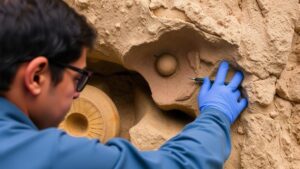Searching for manganese-rich nodules on the seabed of the Pacific Ocean, a potential treasure trove for future miners.
Searching for Manganese-Rich Nodules on the Seabed of the Pacific Ocean
The Pacific Ocean, with its vast expanse and rich geological features, is home to one of the worlds most intriguing and potentially valuable natural resources: manganese-rich nodules. These nodules are not merely geological curiosities; they are significant for their potential economic value and contribution to various industries, particularly for rockhounds and mineral collectors. In this article, we will explore the characteristics of manganese-rich nodules, their geological formation, current mining efforts, and practical tips for collectors looking to add these unique specimens to their collections.
What Are Manganese-Rich Nodules?
Manganese-rich nodules are small, rounded formations found on the ocean floor, predominantly in the deep sea. Composed mainly of manganese and iron oxides, these nodules are typically coated with a layer of valuable metals, including copper, nickel, and cobalt. A typical nodule can range in size from a few millimeters to several centimeters in diameter and can weigh up to several kilograms.
- Manganese: 24-30% – a critical component used in steel production.
- Nichol: 1-2% – essential for battery production.
- Cobalt: 0.1-0.5% – crucial for electronics and electric vehicle batteries.
The nodules grow slowly, often taking millions of years to form just a few centimeters. They develop through geological processes involving the precipitation of metal from seawater onto the nuclei, which might be fragments of rocks or fossils, gradually building layers over time.
Geological Formation and Distribution
Manganese nodules are predominantly found in the abyssal plains of the Pacific Ocean, often located at depths of 4,000 to 6,000 meters. region known as the Clarion-Clipperton Zone (CCZ) is particularly rich in these nodules, with a reported density of approximately 0.5 to 8.0 kilograms per square meter. This area accounts for roughly 1.2 million square kilometers of the seabed, representing a significant potential resource for future extraction efforts.
Geological studies indicate that the formation of manganese nodules is influenced by several factors, including the availability of precursor materials, sedimentation rates, and hydrothermal activity. Understanding these factors is crucial for both scientists studying marine geology and mineral collectors seeking valuable specimens.
Current Mining Efforts and Environmental Concerns
The interest in mining manganese-rich nodules has surged in recent years, driven by the increasing demand for metals in technologies such as renewable energy and electric vehicles. Several international companies and consortiums are vying for exploration contracts in the CCZ. According to the International Seabed Authority (ISA), as of 2023, there are more than 20 exploration contracts granted for manganese nodules. This highlights the potential economic impact of seabed mining while simultaneously raising environmental concerns.
Environmentalists warn that mining activities could disrupt delicate marine ecosystems, which are still not fully understood. extraction process could result in sediment plumes that smother marine life and alter habitats. So, a balance must be struck between resource extraction and environmental conservation.
Practical Tips for Rockhounds and Mineral Collectors
If you are a rockhound or mineral collector curious about manganese-rich nodules, there are several approaches you can take to incorporate these fascinating specimens into your collection:
- Research Local Regulations: Before embarking on any collecting journey, familiarize yourself with local and international regulations concerning marine resource gathering, as many areas prohibit collection without proper permits.
- Join Collectors Groups: Networking with other collectors can provide valuable contacts and information about sources of manganese nodules. Online forums and local mineral clubs are excellent places to start.
- Attend Shows and Auctions: Mineral and gem shows often feature vendors selling unique specimens, including manganese-rich nodules. Keep an eye on listings from reputable dealers.
- Document Your Finds: Keep detailed records of the provenance and the conditions under which you obtained your specimens. This practice is particularly important for maintaining the value of your collection.
Conclusion
Manganese-rich nodules from the Pacific Ocean present an intriguing opportunity not only for the mining industry but also for rockhounds and mineral collectors worldwide. With their unique formation process and valuable metal content, these nodules are true treasures from the deep sea. As exploration and extraction efforts evolve, it will be crucial to navigate the balance between resource exploitation and environmental sustainability. Collectors should approach this exciting field with a thorough understanding of the necessary regulations and the ecological implications associated with marine mineral resources.



